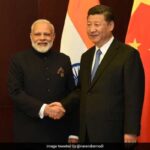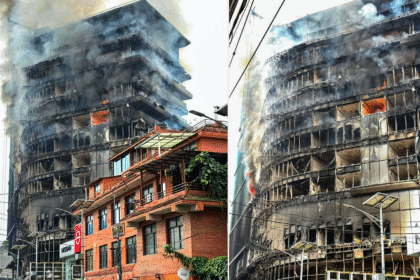Trump India Tariffs 2025 LIVE: Trump Threatens ‘Secondary Sanctions’ as India Stands Firm – 5 Key Updates You Must Know
Trump warns of secondary sanctions over India-Russia trade amid 2025 tariff standoff. India refuses to back down. Follow 5 key live updates now
US President Donald Trump has imposed steeper tariffs on Indian goods over New Delhi’s continued purchase of Russian oil, opening a new front in his trade wars hours before another wave of duties takes effect. The additional 25-per-cent tariff on Indian goods, coming into place in three weeks, stacks atop a separate 25-per cent duty entering into force Thursday, taking the level to 50 per cent for many products.
Exemptions remain, however, for goods targeted under sector-specific duties such as steel and aluminium, and categories that could be hit later, like pharmaceuticals and semiconductors.
India has condemned Trump’s announcement, calling the move “unfair, unjustified and unreasonable.”
The Foreign Ministry has earlier said India began importing oil from Russia as traditional supplies were diverted to Europe over the war — noting that Washington had “actively encouraged” such imports to strengthen “global energy market stability.”

As the U.S. Presidential elections draw closer, former President Donald Trump has once again turned his attention to international trade, this time targeting India over its ongoing commercial ties with Russia. In an explosive remark during a campaign stop in Iowa, Trump warned that if re-elected in November 2025, his administration would not hesitate to impose secondary sanctions on India if it continues trade engagements with Moscow. However, India has responded firmly, reiterating its sovereign right to pursue independent foreign policy and trade relations.
This latest standoff between Trump and India signals a re-escalation of tariff tensions that marked the previous U.S.-India trade chapter during his first term in office. With trade volumes, defence deals, and diplomatic equations on the line, the global geopolitical landscape is watching closely. Here’s a deep dive into the unfolding situation.
At the heart of Trump’s threat is the claim that India’s increasing oil imports and defence transactions with Russia violate the “economic unity” the West seeks against Vladimir Putin. Speaking at a Republican rally in Iowa, Trump said:
“If India wants to keep doing business with Russia while taking our trade benefits, there will be consequences. Sanctions. Strong ones. India must choose: America or Russia.”
He pointed specifically to India’s long-term oil import contracts with Rosneft and its S-400 missile defense system purchase as red flags. Trump warned of “secondary sanctions” under expanded versions of CAATSA (Countering America’s Adversaries Through Sanctions Act), saying it would penalize not only Indian entities but also third-party nations facilitating such deals.
This warning comes despite India being a top trading partner of the U.S., with bilateral goods and services trade surpassing $200 billion in 2024, according to USTR data.
The Indian government swiftly and assertively responded to Trump’s remarks, refusing to be pressured. In a late-night statement, a senior official from the Ministry of External Affairs said:
“India maintains a balanced, multi-aligned foreign policy and will not accept unilateral dictates from any country, former president or otherwise.”
The official emphasized that India has diversified its trade and defense partners, but would not sever ties with Russia, a long-standing ally, especially in critical sectors like energy and military hardware.
New Delhi reminded Washington that India continues to purchase U.S. defense equipment, invests in American tech, and plays a key role in the Indo-Pacific Quad alliance. It also stated that oil imports from Russia are purely commercial and not in violation of any international laws or UN sanctions.

Secondary sanctions refer to U.S. penalties on foreign businesses or governments that engage with sanctioned nations or entities. If implemented, these could have severe ramifications for Indian companies dealing with Russian banks, energy firms, or defense manufacturers.
Indian Oil Corporation for energy contracts
Hindustan Aeronautics Ltd (HAL) for Russian aircraft servicing
Bharat Dynamics Ltd for joint missile ventures
Indian shipping firms and insurers covering crude from Russian ports
Sanctions could mean asset freezes, transaction bans, denial of SWIFT access, and blacklisting from U.S. markets — significantly impacting India’s trade and financial sector.
However, experts say Trump’s statement is speculative, and even if he returns to office, enacting such sanctions would face bureaucratic hurdles and geopolitical resistance.
This isn’t the first time Trump has gone after India on trade. During his first term (2017–2021), Trump:
Withdrew GSP (Generalized System of Preferences) benefits in 2019, worth $6.3 billion in exports
Imposed tariffs on Indian steel and aluminum
Repeatedly called India the “tariff king”
Questioned pharmaceutical pricing and digital tax regulations
Though India retaliated with counter-tariffs, the tension was eventually managed through talks. However, trade negotiations remained incomplete by the end of Trump’s term.
Analysts suggest this latest escalation may be part of Trump’s broader campaign narrative, painting Biden as “soft” and portraying himself as tough on international freeloaders.
India’s refusal to yield to Trump’s pressure is not just about protecting commercial interests—it is about strategic autonomy in an increasingly bipolar world. As global power shifts toward a multipolar reality, India is maintaining ties with Russia, the U.S., EU, and Middle Eastern nations alike.
Some key reasons why India won’t budge:
Defence reliance on Russia: Over 60% of Indian military equipment originates from Russia
Energy security: Discounted Russian crude saved India over $5 billion in 2024
Geopolitical leverage: India remains a balancing force between East and West
Domestic political pressure: Nationalist sentiments favor strategic independence
Moreover, India has successfully navigated U.S. sanctions threats before, including during its S-400 purchase under CAATSA during Trump’s own presidency — without any penalties being imposed.
International reactions have been mixed. While European leaders have stayed largely silent, some U.S. foreign policy experts have warned against alienating India at a time when it is a vital counterbalance to China.
Meanwhile, Russia praised India’s firm stand. Russian Foreign Ministry spokesperson Maria Zakharova said:
“India is a sovereign power. We appreciate their principled stance and constructive cooperation in global energy, defense, and security.”
In contrast, Chinese state media highlighted the friction, arguing that Washington’s overreach is pushing India closer to Beijing and Moscow.
Whether Trump’s warning will translate into actual sanctions depends on multiple variables:
Will Trump win in November 2025?
Will his administration follow through with legal frameworks for secondary sanctions?
Will India adjust its procurement strategy under global pressure?
So far, Indian markets have remained stable, with the Nifty and Sensex closing flat, showing confidence that this may be a political ploy rather than a policy certainty. However, experts warn that if tensions escalate, bilateral trade talks may freeze, and supply chain disruptions could follow.
India’s Commerce Ministry has reportedly reached out to USTR officials for clarification and has prepared legal and diplomatic countermeasures should the U.S. proceed with punitive steps.








